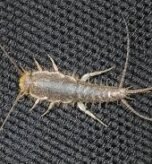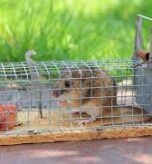Chinch bugs are tiny yet highly destructive pests that can inflict considerable damage on turfgrass, especially during warm, dry weather. An infestation is often mistaken for drought stress, which allows it to escalate rapidly and lead to extensive lawn degradation. This guide provides a professional overview of chinch bugs, covering their identification, the signs of chinch bug damage, and comprehensive strategies for prevention and treatment.
What Are Chinch Bugs? A Look at Identification
Chinch bugs are small insects, typically measuring under ¼ inch long. Their bodies are dark red to black and feature distinctive white wings that often form a cross-shaped pattern when folded. The immature stages, known as nymphs, are bright red or orange with a noticeable white band across their abdomen, which darkens as they mature.
Several chinch bug species inhabit North America. The hairy chinch bug is common in the northeastern and midwestern states, while the southern chinch bug is the most destructive variant in warm-season lawns across the southeastern U.S. and parts of California.
Recognizing the Signs of Chinch Bug Damage
Chinch bugs cause severe lawn damage by piercing grass blades, sucking out the sap, and injecting a toxin that blocks water movement within the plant. This feeding process desiccates the grass, leading to distinct patterns of decline.
Symptoms of Chinch Bug Damage
Initial signs of chinch bug damage include small, irregular patches of grass that look dry, wilted, or yellowed. These affected areas often expand outward, merging into larger, browning, and brittle patches. If you leave it unaddressed, the severely infested grass may turn a straw color and easily pull away from the soil, often resulting in complete lawn loss.
Is It Chinch Bug Damage or Drought Stress?
People commonly misidentify chinch bug damage as drought stress because both conditions result in dry, browning grass. A key difference is that grass damaged by chinch bugs will not recover, even with regular watering. Chinch bugs thrive in hot, dry, sunny areas, especially near heat-radiating surfaces like driveways and sidewalks.
The Chinch Bug Life Cycle and When to Expect Damage
Chinch bugs become active with warming spring temperatures. Females lay eggs from spring to summer, usually producing two generations annually. The peak feeding period, when chinch bug damage is most severe, occurs from late June through September.
How to Diagnose a Chinch Bug Infestation
Accurate diagnosis is essential for implementing the correct treatment and preventing unnecessary interventions.
The Flotation Test: A Simple Diagnostic Tool
A highly effective method for confirming the presence of chinch bugs is the flotation test.
- Prepare the Can: Remove both ends of a large metal can, like a coffee can.
- Insert into Turf: Press the can firmly into the soil, about 2-3 inches deep, at the edge of a damaged area where it meets healthy grass.
- Fill with Water: Fill the can about three-quarters full with water. You can add a tablespoon of dish soap to help.
- Observe: Let it sit for 5-10 minutes. Any chinch bugs present will float to the surface.
If you count 15-20 or more chinch bugs per square foot, you have a moderate to serious infestation that requires treatment.
Preventing Chinch Bug Damage with a Healthy Lawn
Implementing proactive lawn care practices is the most effective way to prevent chinch bug damage and cultivate a resilient lawn.
Optimized Lawn Maintenance to Prevent Chinch Bugs
- Proper Watering: Consistent and deep irrigation is crucial, especially during hot, dry periods. Aim for 1 inch of water per week, applied deeply but infrequently.
- Thatch Management: A thick thatch layer provides ideal shelter for chinch bugs. Regular dethatching, especially in the spring, reduces their habitat.
- Appropriate Mowing Height: Mowing your lawn regularly and maintaining a height of 2-2.5 inches helps retain moisture and reduces grass stress.
- Balanced Fertilization: Avoid excessive nitrogen fertilization, which can make your lawn more susceptible to chinch bug damage.
- Lawn Aeration: Regular aeration alleviates compacted soil, which chinch bugs prefer.
Choosing Resistant Grass Varieties
Using chinch bug-resistant turfgrass cultivars can significantly reduce your risk. Certain varieties of perennial ryegrass and fescues contain naturally occurring endophytic fungi. These fungi produce chemicals that are unpalatable to chinch bugs. The ‘Floratam’ variety of St. Augustinegrass is also known for its resistance.
Encouraging Natural Predators
Promoting beneficial insects that prey on chinch bugs can help with natural population control. Key predators include big-eyed bugs, ground beetles, and earwigs.
How to Treat Chinch Bug Damage
When an infestation is already established, you may need a multi-faceted approach.
Eco-Friendly and Biological Treatment Methods
- Beneficial Nematodes: These are microscopic worms that target chinch bug nymphs in the soil.
- Diatomaceous Earth (DE): This natural powder damages the chinch bugs’ exoskeletons, leading to dehydration.
- Insecticidal Soap: A mild soap solution can suffocate chinch bugs on contact.
Chemical Control for Chinch Bug Damage
For moderate to severe infestations, chemical insecticides may be necessary. Effective ingredients include bifenthrin and imidacloprid. The summer is generally the most effective time for treatment. A follow-up treatment 2-4 weeks later is often recommended.
When to Call a Professional
For extensive or severe chinch bug damage, a professional lawn care service is highly recommended. Professionals have access to more potent products and the expertise to apply them safely and effectively.
Restoring Your Lawn After Chinch Bug Damage
After you have controlled the chinch bugs, you may need to restore your lawn. The best time for this is late summer or early spring.
- Prepare the soil by removing thatch and aerating.
- Overseed or plug the damaged areas with an appropriate grass mix.
- Water regularly to maintain consistent soil moisture for the new grass.
Conclusion
Chinch bugs pose a significant threat to your lawn’s health. Effective management of chinch bug damage relies on accurate identification, proactive lawn care, and targeted treatments when necessary. By understanding their life cycle and implementing robust care practices, homeowners can cultivate and maintain a resilient, beautiful, and chinch bug-free outdoor space.



